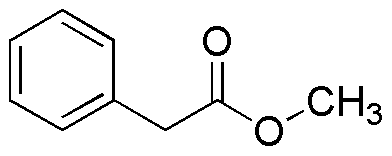Methyl phenylacetate is widely utilized in research focused on:
- Fragrance Industry: This compound is a key ingredient in perfumes and fragrances due to its pleasant sweet and fruity aroma, making it a popular choice for cosmetic formulations.
- Flavoring Agent: It is used in the food industry as a flavoring agent, imparting a fruity taste to various products such as candies and beverages.
- Solvent Applications: Methyl phenylacetate serves as an effective solvent in the formulation of paints, coatings, and adhesives, enhancing the performance and drying time of these products.
- Research and Development: In laboratories, it is often utilized as a reagent in organic synthesis, aiding researchers in the development of new chemical compounds and materials.
- Pharmaceuticals: This compound is explored for its potential applications in drug formulation, particularly in enhancing the solubility and bioavailability of active pharmaceutical ingredients.
General Information
Properties
Safety and Regulations
Applications
Methyl phenylacetate is widely utilized in research focused on:
- Fragrance Industry: This compound is a key ingredient in perfumes and fragrances due to its pleasant sweet and fruity aroma, making it a popular choice for cosmetic formulations.
- Flavoring Agent: It is used in the food industry as a flavoring agent, imparting a fruity taste to various products such as candies and beverages.
- Solvent Applications: Methyl phenylacetate serves as an effective solvent in the formulation of paints, coatings, and adhesives, enhancing the performance and drying time of these products.
- Research and Development: In laboratories, it is often utilized as a reagent in organic synthesis, aiding researchers in the development of new chemical compounds and materials.
- Pharmaceuticals: This compound is explored for its potential applications in drug formulation, particularly in enhancing the solubility and bioavailability of active pharmaceutical ingredients.
Documents
Safety Data Sheets (SDS)
The SDS provides comprehensive safety information on handling, storage, and disposal of the product.
Product Specification (PS)
The PS provides a comprehensive breakdown of the product’s properties, including chemical composition, physical state, purity, and storage requirements. It also details acceptable quality ranges and the product's intended applications.
Certificates of Analysis (COA)
Search for Certificates of Analysis (COA) by entering the products Lot Number. Lot and Batch Numbers can be found on a product’s label following the words ‘Lot’ or ‘Batch’.
*Catalog Number
*Lot Number
Certificates Of Origin (COO)
This COO confirms the country where the product was manufactured, and also details the materials and components used in it and whether it is derived from natural, synthetic, or other specific sources. This certificate may be required for customs, trade, and regulatory compliance.
*Catalog Number
*Lot Number
Safety Data Sheets (SDS)
The SDS provides comprehensive safety information on handling, storage, and disposal of the product.
DownloadProduct Specification (PS)
The PS provides a comprehensive breakdown of the product’s properties, including chemical composition, physical state, purity, and storage requirements. It also details acceptable quality ranges and the product's intended applications.
DownloadCertificates of Analysis (COA)
Search for Certificates of Analysis (COA) by entering the products Lot Number. Lot and Batch Numbers can be found on a product’s label following the words ‘Lot’ or ‘Batch’.
*Catalog Number
*Lot Number
Certificates Of Origin (COO)
This COO confirms the country where the product was manufactured, and also details the materials and components used in it and whether it is derived from natural, synthetic, or other specific sources. This certificate may be required for customs, trade, and regulatory compliance.

